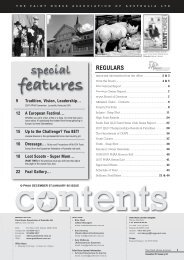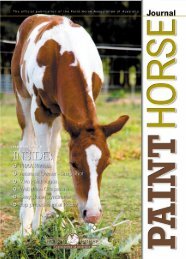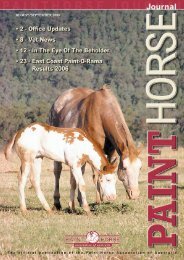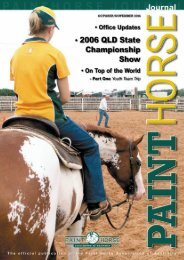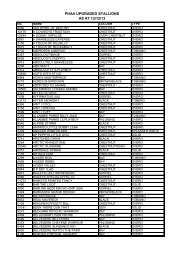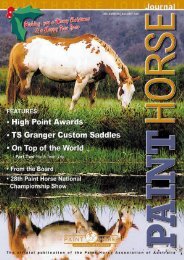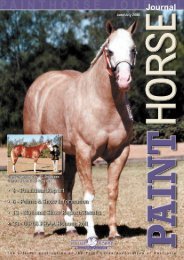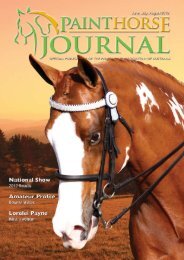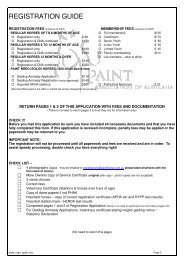PaintHorseJournal-2010-December V2:Layout 1
PaintHorseJournal-2010-December V2:Layout 1
PaintHorseJournal-2010-December V2:Layout 1
Create successful ePaper yourself
Turn your PDF publications into a flip-book with our unique Google optimized e-Paper software.
WANTED DEAD OR ALIVE<br />
Article: Carol Rushby Main Photo: Tania Hobbs<br />
You have a horse that is hard to catch, a foal that you are halter training, or a hood<br />
that needs a halter over it to hold it in place, and it makes so much sense to leave<br />
the halter on; you have checked the paddock or yard to make sure there is nothing<br />
that could catch on the halter, so you feel safe in leaving the halter on and your life<br />
is so much easier.<br />
Most people don’t realize just what a dangerous<br />
piece of equipment a halter can<br />
be, however. A halter can snag on a onecentimetre<br />
protrusion and it is a very<br />
rare horse that will just stand and wait<br />
for help when they are unexpectedly attacked<br />
by a gate, tree, or tap, let alone a<br />
hind foot that is suddenly locked to their<br />
head! Horses are a prey animal and you<br />
can never completely over-ride millions<br />
of years of instinct which has taught them<br />
that the way to survive attack is to flee.<br />
Even a quiet older horse may panic under<br />
these circumstances.<br />
The ‘western’ rope halters are particularly<br />
dangerous as they are made not to break,<br />
and the rope used is not only strong but<br />
is also quite a small diameter.This concentrates<br />
the pressure over the poll behind<br />
the ears, and can cause extreme pain if<br />
there is several hundred kilos of horse<br />
trying to escape whatever is attacking it.<br />
Never ever leave one of these rope halters<br />
on a horse unless you are standing<br />
beside it!<br />
The following instances are just a<br />
few examples of what has happened<br />
when halters were left on.<br />
• A Quarter Horse foal with a training<br />
halter left on to make it easier to catch<br />
her for handling. She managed to get a<br />
hind foot caught in the side of the halter<br />
when scratching and broke two legs<br />
in her struggles. Cause of death – euthanized<br />
when the vet arrived an hour later.<br />
• A lovely show mare turned out for exercise.<br />
The inside heel of the shoe on her<br />
hind foot caught on the cheek-piece of<br />
her halter and she crashed down the side<br />
of a hill. Cause of death – broken neck.<br />
• A lovely Paint foal at a show for a Weanling<br />
Futurity. The halter was left on to<br />
stop the hood from dislodging.The foal<br />
was found in the morning hanging from<br />
the stall gate, with the underneath of the<br />
halter caught on the 5cm knob of the<br />
sliding bolt on the outside of the gate.<br />
Cause of death – shock after severe<br />
trauma to front legs.<br />
• A two-year old Appaloosa gelding, a little<br />
hard to catch sometimes; turned out for<br />
a run in the arena. He reached over the<br />
rails at the end of the arena to scratch<br />
his chin and the halter caught on the end<br />
of the top rail. Cause of death – broken<br />
neck.<br />
By far a better alternative is to practice a<br />
lot of ‘catch-and-release’ with your horse.<br />
Don’t expect him to want to be caught if<br />
the only time you catch him is for work<br />
or shove a drench down his throat. Make<br />
being ‘officially’ caught a part of his daily<br />
routine. “You-no-catching-me” means his<br />
feed walks away and doesn’t come back<br />
til the next day (if necessary).<br />
Start out by demanding<br />
a touch on<br />
the neck in exchange<br />
for<br />
the feed,<br />
then extend<br />
that demand<br />
to getting touched<br />
and rubbed around<br />
the neck and face,<br />
then he must have<br />
a halter put on before<br />
he gets the<br />
feed. Once the<br />
horse gives in, you<br />
put the halter on<br />
pat him and then just remove it again. A<br />
bit of time spent in establishing the rules<br />
can save a lot of problems down the track,<br />
particularly with a youngster<br />
If you absolutely have to leave something<br />
on a horses head, you can purchase ‘breakaway’<br />
halters which have a weak spot built<br />
in; or alternatively, use a ‘thoroughbred’<br />
neck strap, which also has a built in breakaway<br />
buckle tongue. You can make your<br />
own breakaway neck strap from an old<br />
webbing halter. Cut off the cheek straps<br />
and noseband (shadowed), leaving the jowl<br />
to chin under-jaw strap and the straps that<br />
normally go under the jowl and over the<br />
poll. If possible use bolt cutters on the ring<br />
under the chin and just thread a short<br />
length of plaited string through the loop<br />
where the ring was. Do the ‘neck-strap’<br />
up fairly snugly around the horses<br />
neck, just behind the ears, and<br />
DO NOT put the end of the<br />
strap back thru the buckle.<br />
This will provide an additional<br />
weak point because<br />
if the horse does get caught<br />
up the buckle-tongue will<br />
give way quite easily. Anything<br />
else left on a horse is<br />
simply an accident waiting<br />
to happen.<br />
You may think you are<br />
wasting a lot of time trying<br />
to catch a recalcitrant<br />
horse, but remember –<br />
he will be easy to catch<br />
if he is dead!<br />
<strong>December</strong> <strong>2010</strong> - February 2011 | PAINT HORSE JOURNAL 43



